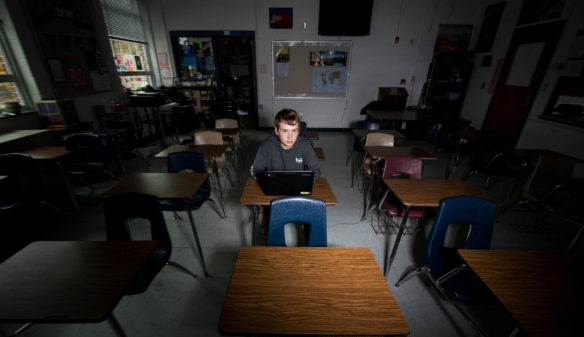
Chronic absenteeism is taking significant numbers of students away from Kentucky classrooms. The Kentucky Department of Education’s measures to combat chronic absenteeism include making it a part of the new accountability system that will be put in place next year.
Photo Illustration by Bobby Ellis, Nov. 8, 2017
By Mike Marsee
mike.marsee@education.ky.gov
Educators often say that students cannot learn if they aren’t in school. Troy Brock sees it differently.
Brock, the director of pupil personnel for Paducah Independent schools, said learning takes place whether students are in the classroom or not.
“Absolutely,” Brock said. “Kids are always learning, even when they’re not there. They’re just not learning what you have planned for them to learn.”
Chronic absenteeism is typically defined as a student missing 10 percent or more of the school year for any reason.
In the past few months, the Kentucky Department of Education (KDE) took a significant step to combat chronic absenteeism by calling for it to be a measurement in the new accountability system that was approved by the Kentucky Board of Education earlier this fall.
“It’s a different way of thinking about school performance than maybe we have in the past, but hopefully that will help boost achievement in the end. People have often been concerned about scores the most, and they haven’t been too concerned about the attendance piece,” said Christina Weeter, the director of KDE’s Division of Student Success.
A definition of chronic absenteeism has been written into a new regulation relating to the accountability plan. Schools and districts can now enter and track chronic absence rates that are based on that definition in Infinite Campus, Weeter said.
A state-by-state analysis of school-level chronic absence by Attendance Works based on data collected in 2013-14 by the federal Office of Civil Rights found that 58 percent of Kentucky schools had chronic absence rates ranging from significant (10 to 19.9 percent) to extreme (30 percent or more). Ten percent of Kentucky schools had extreme levels of chronic absenteeism, compared with the median of 8 percent.
Nationally, nine out of 10 school districts experience some level of chronic absenteeism, according to the Attendance Works analysis, but half of the nation’s chronically absent students are concentrated in just 4 percent of its districts.
Paducah Independent wasn’t one of those districts. Brock said its attendance rate was one of the highest in the state just a few years ago at better than 97 percent.
“It has always been one of the concerns that we tried to address, but we tried to address it more in the past from the standpoint of truancy, more from the legal side of things,” Brock said. “We almost overlooked the idea of chronic absenteeism. It really wasn’t one of those barnburner issues at the forefront of your mind, but when the feds came out with their report looking at it, we started looking at it.”
Brock got a closer look when he was invited to be part of a working group consisting of KDE staff members, representatives of other agencies and other shareholders that traveled to Washington for a conference on chronic absenteeism. The group has continued to work toward reducing chronic absenteeism in the state.
“That really helped me understand what the major concern is and to look at it on the broader scale,” he said.
Brock said chronic absenteeism has gone up in the Paducah schools, from 7 percent a few years ago to more than 10 percent now, “despite our best efforts to communicate, to educate and to work with the schools and families and community leaders.”
He said the district has taken a more proactive approach to the problem.
“We’ve become intentional in our focus on rising issues of absenteeism,” he said. “We’re looking at a tiered approach. It starts at the bottom tier with communicating attendance expectations with families, but also with soft sells: What are the impacts of your child not being in school for 10 percent of the school year?”
Brock said those impacts are too significant to ignore.
“The research is very suggestive that by the 4th grade, chronically absent students’ literacy levels are much lower,” he said. “It’s vitally important, particularly in kindergarten through 3rd grade, that they be in school as much as possible.”
Weeter said high attendance rates can sometimes hide a chronic absenteeism problem.
“Looking at your attendance score in the School Report Card is not necessarily indicative of whether you have a chronic absenteeism problem,” she said. She said having chronic absenteeism built into the accountability system should help schools and districts see the need to address it.
“Attendance Works has made a big push for states to consider chronic absenteeism as a school quality indicator,” Weeter said. “A number of states signed on for that, and it made sense for Kentucky to look at that.
“I think it’s going to open some eyes in districts. Some of our top-performing schools and districts have great attendance rates, but that can mask where there are pockets of chronic absenteeism in certain student groups. The fact that it’s going to be part of the accountability system is going to shine a light on the need to address that.”
McNabb Elementary School in the Paducah Independent district has been addressing chronic absenteeism throughout Teresa Spann’s five years as the school’s principal. Spann and her staff have been using the school’s attendance data to find students who are missing a significant number of days and try to get them back in the classroom.
“We look at the data to pinpoint individual students and their families and figure out what those kids need,” she said.
That might be something small such as an alarm clock or gasoline for the car that gets those students to school, things that can be provided by the family resource and youth service center. It might be a conversation with a parent who isn’t getting a child to school, and it might even lead to involvement with social services or law enforcement.
“This is my 20th year in the district, and we’ve established some strong relationships with families. They know that our expectations are high, and we’re eliminating every excuse,” Spann said.
Like many schools, McNabb Elementary encourages and celebrates high attendance; it won the district’s monthly traveling attendance award twice last year. Spann said the school’s attendance rate was 96.2 percent last year and is close to 97 percent so far this year.
“Everything is affected by low attendance,” she said. “Attendance is at the heart of everything we do.”
MORE INFO …
Troy Brock troy.brock@paducah.kyschools.us
Teresa Spann teresa.spann@paducah.kyschools.us
Christina Weeter christina.weeter@education.ky.gov




As an educator, I agree that absenteeism negatively impacts student learning of core standards as well as soft skills. However, I am greatly concerned that local schools are being held accountable for improving student attendance. The number of responsibilities administrators and teachers have placed on them is so numerous that there is limited time or energy available for actually providing quality education. Adding to the “to do” list and simply measuring is not going to provide the level of intervention that is necessary to resolve the factors contributing to increased student absenteeism. Oh how I wish other community agencies and resources were a part of the mandated plan to fight the absenteeism battle.
I am very disappointed in Christina Weeter and her comments in this article.
“It’s a different way of thinking about school performance than maybe we have in the past, but hopefully that will help boost achievement in the end. People have often been concerned about scores the most, and they haven’t been too concerned about the attendance piece,” said Christina Weeter, the director of KDE’s Division of Student Success.
This is an false and uninformed statement to make about attendance and public schools. Every school district in the state of KY has FRC/YSC, Student Services, Attendance Specialist and DPP’s that spend all or part of their days focused on removing barriers to school attendance for KY students and families. To state schools “haven’t been too concerned about the attendance piece” is outrageous. What is the missing piece? Community. Communities must come together and work with their health care professionals and mental health professionals and courts and dentist, etc etc. to make it unacceptable for students to miss school. Make it unacceptable to provide only day time—school time– appointments. Make it unacceptable to provide excuses — dr note– anytime a parent request one. Attendance is a community issue — the school, the community, the parents– must all work together to make it unacceptable to miss school. If students are not in the seat – then they are not learning— but to insinuate much less state that school districts haven’t been to concerned is unacceptable.